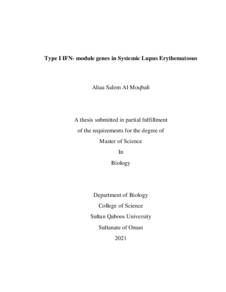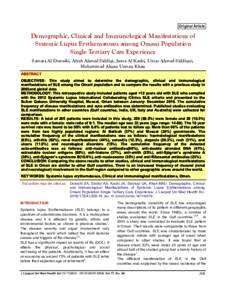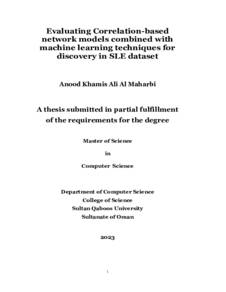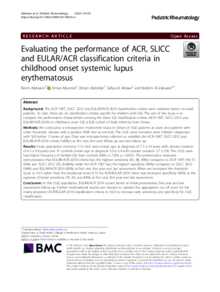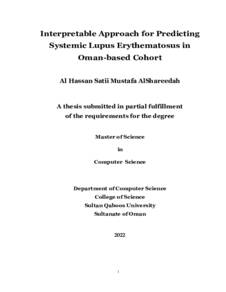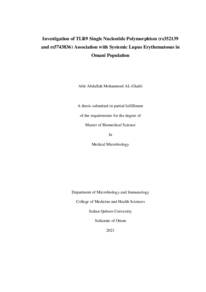Document
Type I IFN- module genes in systemic lupus erythematosus.
Other titles
النوع الأول من جينات -IFN في الذئبة الحمراء الجهازية
Publisher
Sultan Qaboos University.
Gregorian
2021
Language
English
Subject
English abstract
Systemic Lupus Erythematosus (SLE) is a multisystemic autoimmune disease characterized by excessive production of type Ι IFNs, autoantibodies and immune complexes causing different organ damage. SLE is associated with a defect in self tolerance due to dysregulated innate and adaptive immune cells. The breakdown of tolerance to nuclear antigens, especially nucleic acids, result in widespread organ damage. Type Ι IFN affects the immunological roles of immune cells especially monocytes, T cells and B cells that are involved in the loss of tolerance and autoimmunity in SLE. Environmental factors are suggested to be responsible for the
induction of SLE disease in genetically susceptible individuals. In this study, the
potential differential expression of representative genes for the three type I IFN
modules (RSAD2 from M1.2, GBP1 from M3.4 and IRF9 from M.12) were
investigated and their association with monocytes and T-cell subtypes differentiation
and SLE manifestations was evaluated. The results showed that the three genes are
not significantly correlated with monocytes. There is no significant correlation
between RSAD2, GBP1 and IRF9 and T-cell subtypes, although a moderate
correlations is found only between IRF9 and Treg. GBP1 and IRF9 are significantly
associated with joint pain manifestation in SLE patients. Conclusion: GBP-1 and
IRF9 can be utilized as biomarkers for joint pain in SLE.
Member of
Resource URL
Arabic abstract
الذئبة الحمراء الجهازية )SLE )هو مرض مناعي ذاتي متعدد الأنظمة يتميز بالإنتاج المفرط
لبروتينات مناعية من النوع IFNs والأجسام المضادة الذاتية والمركبات المناعية التي تسبب تلفًا
لأعضاء مختلفه. يرتبط مرض الذئبة الحمراء بخلل في تمييز الخلايا والأنتيجينات الذاتية بسبب
خلال في عمل الخلايا المناعية الفطرية والتكيفية. تحلل الأحماض النووية الذاتية الناتجة من
التحلل الطبيعي للخلايا التالفة )apoptosis )، وخاصة ال DNA، التي يعتبرها جهاز المناعة
كأنتيجينات غريبة فيهاجمها مما يؤدي إلى تلف الأعضاء على نطاق واسع. يؤثر النوع IFN Ι
على الأدوارالطبيعية للخلايا المناعية وخاصة الخلايا الوحيدة )Monocytes )والخلايا
العارضة لألنتيجين والخلايا التائية والبائية التي تشارك في المناعة الذاتية في مرض الذئبة
الحمراء. يُقترح أن تكون العوامل البيئية مسؤولة عن تحريض مرض الذئبة الحمراء في الأفراد
المعرضين وراثيًا. في هذه الدراسة تم فحص التعبير التفاضلي المحتمل للجينات
التمثيلية(9IRF & 1GBP 2,RSAD (لوحدات IFN الثالثة من النوع الأول )1.2M و
3.4M و .12M )وتم تقييم الأرتباط مع الخلايا الأحادية و الأنواع الفرعية للخلايا التائية
ومظاهر SLE. أظهرت النتائج أنه يوجد اختلاف في التعبير الجيني للجينات الثلاثة في المصادر
ارتباطا وثيقًا الثلاثة للRNA. و لكن لا يرتبط اختلاف التعبير الجيني للجينات الثلاثة بالخلايا
ارتباط الأحادية وأنواع الخلايا التائية الفرعية. وجدت الدراسة فقط ارتباطا متوسطا بين 9IRF والنوع
Treg من الخلايا التائية المختبرة. يمكن استخدام -1GBP و 9IRF كمؤشرات حيوية آلالم
المفاصل المرتبطه بمرض الذئبة الحمراء.
لبروتينات مناعية من النوع IFNs والأجسام المضادة الذاتية والمركبات المناعية التي تسبب تلفًا
لأعضاء مختلفه. يرتبط مرض الذئبة الحمراء بخلل في تمييز الخلايا والأنتيجينات الذاتية بسبب
خلال في عمل الخلايا المناعية الفطرية والتكيفية. تحلل الأحماض النووية الذاتية الناتجة من
التحلل الطبيعي للخلايا التالفة )apoptosis )، وخاصة ال DNA، التي يعتبرها جهاز المناعة
كأنتيجينات غريبة فيهاجمها مما يؤدي إلى تلف الأعضاء على نطاق واسع. يؤثر النوع IFN Ι
على الأدوارالطبيعية للخلايا المناعية وخاصة الخلايا الوحيدة )Monocytes )والخلايا
العارضة لألنتيجين والخلايا التائية والبائية التي تشارك في المناعة الذاتية في مرض الذئبة
الحمراء. يُقترح أن تكون العوامل البيئية مسؤولة عن تحريض مرض الذئبة الحمراء في الأفراد
المعرضين وراثيًا. في هذه الدراسة تم فحص التعبير التفاضلي المحتمل للجينات
التمثيلية(9IRF & 1GBP 2,RSAD (لوحدات IFN الثالثة من النوع الأول )1.2M و
3.4M و .12M )وتم تقييم الأرتباط مع الخلايا الأحادية و الأنواع الفرعية للخلايا التائية
ومظاهر SLE. أظهرت النتائج أنه يوجد اختلاف في التعبير الجيني للجينات الثلاثة في المصادر
ارتباطا وثيقًا الثلاثة للRNA. و لكن لا يرتبط اختلاف التعبير الجيني للجينات الثلاثة بالخلايا
ارتباط الأحادية وأنواع الخلايا التائية الفرعية. وجدت الدراسة فقط ارتباطا متوسطا بين 9IRF والنوع
Treg من الخلايا التائية المختبرة. يمكن استخدام -1GBP و 9IRF كمؤشرات حيوية آلالم
المفاصل المرتبطه بمرض الذئبة الحمراء.
Category
Theses and Dissertations

